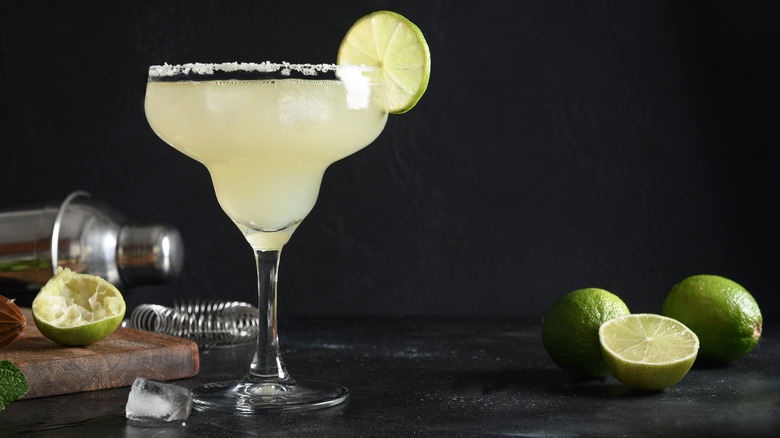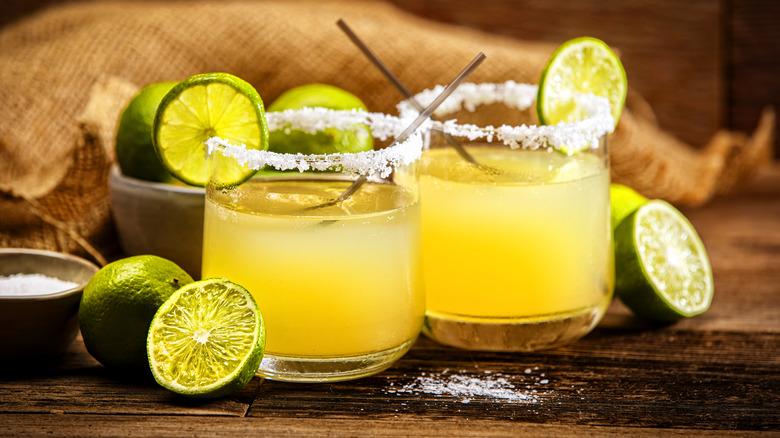Instantly Upgrade Margaritas With A Good, Hard Shake
It is possible to make great blended margaritas, but this is a cocktail that's at its best when shaken, and vigorously at that. In fact, one of the easiest ways to upgrade the quality of your margarita is simply to give it a good, hard shake. Not only does this properly harmonize and chill the ingredients, but it also aerates the cocktail, giving it a better, frothier texture.
The margarita is having more than a moment right now. This influential cocktail, featuring tequila, lime juice, and orange liqueur, isn't just topping the cocktail charts in the United States, but is also the reigning favorite worldwide. Its soaring popularity can be attributed, in part, to the abundance of high-quality ingredients currently available, particularly the plethora of excellent tequila options. The base liquor of the margarita is also experiencing a boost in popularity, positioning itself to potentially surpass vodka as the nation's best-selling spirit.
However, the margarita hasn't always benefited from great ingredients. For decades, the Mexico-born mixed drink seemed as if it would be relegated to the frozen drink category, where it was too often made with well tequilas and uninspiring sweet and sour mixes. Fortunately, however, the craft cocktail boom of the past few decades has helped to give this iconic cocktail the respect it deserves, and the result is sky-high popularity.
Why margaritas are meant to be shaken
Some drinks are made to be shaken, and some are made to be stirred. This old bartending axiom isn't simply a matter of taste, it actually has roots in the composition of cocktails, and the ways in which this can affect taste. For drinks that are predominantly made up of liquor or liqueurs — the martini, for example — stirring is preferred. This is to preserve the unique flavors of the primary ingredients and to prevent watering them down via hard shaking.
Vigorous shaking of cocktails, by contrast, harmonizes the disparate flavors and is almost always better for cocktails that blend base liquors with a mix of non-alcoholic ingredients. Yes, this vigorous shaking of ingredients over ice will slightly dilute the drink, but this can actually be beneficial in terms of taking the edge off of strong liquor or intense citrus flavors. In fact, drinks that use citrus fruit, as a rule, should always be given brisk shaking.
Because of the margarita's reliance on fresh lime juice, this means it's always going to be better if it's shaken rather than stirred. Many margarita recipes now also incorporate agave nectar for added sweetness, and a good shake will also help to balance the lime and syrup flavors with those of the tequila and orange liqueur (whether it's Triple Sec, Cointreau, Grand Marnier, or other options).
How to properly shake your margarita, and other tips
You've carefully chosen your ingredients, from quality tequila to fresh limes and sea salt for the rim of your glass, and now you're ready to shake up your upgraded margarita. What exactly is the proper technique for shaking? The goal is to visibly frost your cocktail shaker, so hard shaking is always preferred to the alternative. For the best results, hold the shaker with two hands, and shake vigorously for at least 10 seconds.
Ice is an underrated part of shaking your cocktails, and using good cubes will definitely improve the quality of your drink. That's because ice not only chills the drink, but the degree to which it melts can also have a big impact on the intensity of flavor. Basically, the bigger the ice cubes the better when it comes to making margaritas. Bigger cubes melt slower, particularly when shaken vigorously, and thus don't water your drink down quite as much. Shaved ice, which melts faster, is preferred for stirred cocktails like the martini.
Why is sea salt better than table salt for rimming margarita glasses? It's not just aesthetic. In fact, sea salt typically doesn't stick to the glass as well. But it has a much finer flavor than table salt, and it balances wonderfully with the margarita's traditional sweet and sour flavor profile.



